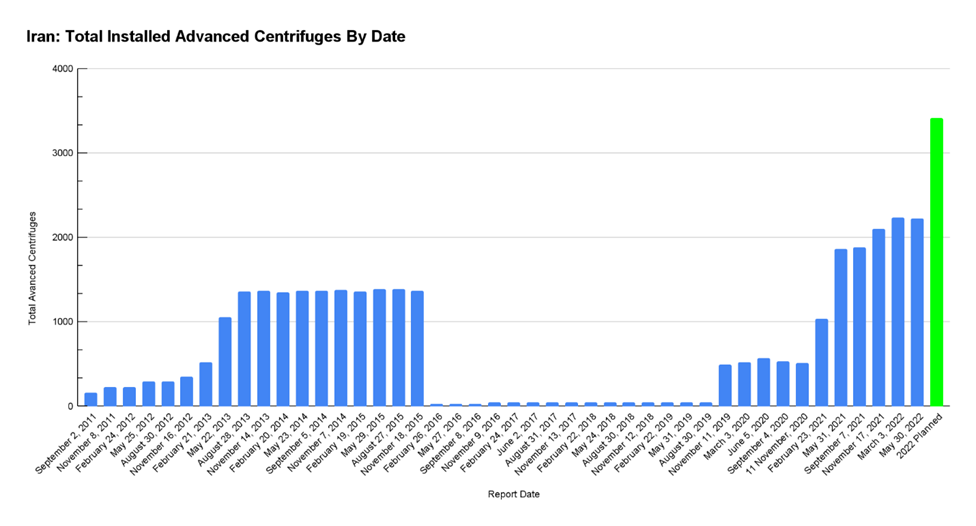Reports
Updated Highlights of Comprehensive Survey of Iran’s Advanced Centrifuges - June 2022 [1]
by David Albright, Sarah Burkhard, and Spencer Faragasso
June 13, 2022

Photo Credit: Iran’s AFTAB News
Advanced Centrifuge Deployments
In the last two and a half years, Iran has been deploying advanced centrifuges in violation of the limits in the Joint Comprehensive Plan of Action (JCPOA), following a lull of three years created by those limits. Starting in late 2020 or early 2021, it dramatically increased the number of deployed advanced centrifuges. Iran has demonstrated its commitment to replace the IR-1 centrifuge with advanced centrifuges, which can produce considerably more enriched uranium.
Iran has been deploying advanced centrifuges at three enrichment plants–the Natanz above-ground Pilot Fuel Enrichment Plant (PFEP), and the much bigger, below-ground Fuel Enrichment Plant (FEP), and the deeply buried Fordow Fuel Enrichment Plant (FFEP). Iran’s deployments have been less than expected based on Iran’s official plans, but Iran continues to express its intention to accelerate them, particularly deployments of the IR-4 and IR-6 centrifuges.
Figure H.1 shows the number of advanced centrifuges deployed from 2011 onwards through May 2022, with a projection for late 2022 based on Iran’s announced plans. Despite the increases in 2021, it is now apparent that Iran’s recent deployments of advanced centrifuges have been slower than planned. In fact, the number of deployed advanced centrifuges did not increase in the last three months.
One likely cause is the destruction of the Natanz Iran Centrifuge Assembly Center (ICAC) and a centrifuge manufacturing plant at a site called TABA Karaj (also known as TESA), situated near Karaj. The ICAC was built to have a capacity to make a few to several thousand advanced centrifuges per year. Iran’s subsequent manufacturing and assembly capacity appears to have been substantially reduced, down to a level of several hundred advanced centrifuges per year. Its temporary assembly facility, inaugurated at Natanz in April 2021, about 9 months after the attack on the ICAC, has failed to compensate for the destruction. Shortly after this inauguration, an attack on Iran’s centrifuge manufacturing capabilities at Karaj likely delayed production of centrifuges further. The subsequent, recent moving of manufacturing capabilities to Natanz further contributed to production delays.
Despite these delays, considering Iran’s ongoing commitment to earlier announced plans, as well as recent affirmation of its determination to increase the number of installed advanced centrifuges, Iran will likely accelerate installation of advanced centrifuges, albeit at a slower rate than it could have without the destruction of these two facilities.
As it does so, uncertainties will likely grow in the estimated number of advanced centrifuges produced in excess of those deployed, adding concern to the possibility that Iran will again seek to build a clandestine enrichment plant, using advanced centrifuges manufactured in secret. Iran was stymied by Western pressure in the 2000s from secretly building an underground enrichment plant at Qom (now called Fordow) to make weapon-grade uranium. Today, it could revitalize that plan, moving to build an enrichment plant with 1000 IR-6 centrifuges, achieving significantly more enrichment output in a smaller space than Fordow with its planned 3000 IR-1 centrifuges.

Figure H.1. Iran’s quarterly number of installed advanced centrifuges at its three enrichment plants, with a multi-quarter projection late-2022 (last vertical bar). (The number of IR-1 centrifuges are ignored in this graph but see Figure H.3 for a complete breakdown of the situation today.) In April 2021, the Natanz FEP was attacked, affecting half of the IR-2m and IR-1 cascades. The total number of installed cascades remained the same but many of the centrifuges could have been destroyed. Since the attack, Iran likely replaced the broken centrifuges in those cascades, although the IAEA does not report how many centrifuges were replaced.
Read the full report in pdf here.
1. David Albright, Sarah Burkhard, and Spencer Faragasso, “A Comprehensive Survey of Iran’s Advanced Centrifuges,” Institute for Science and International Security, December 2, 2021, https://isis-online.org/isis-reports/detail/a-comprehensive-survey-of-irans-advanced-centrifuges/8. ↩

 twitter
twitter